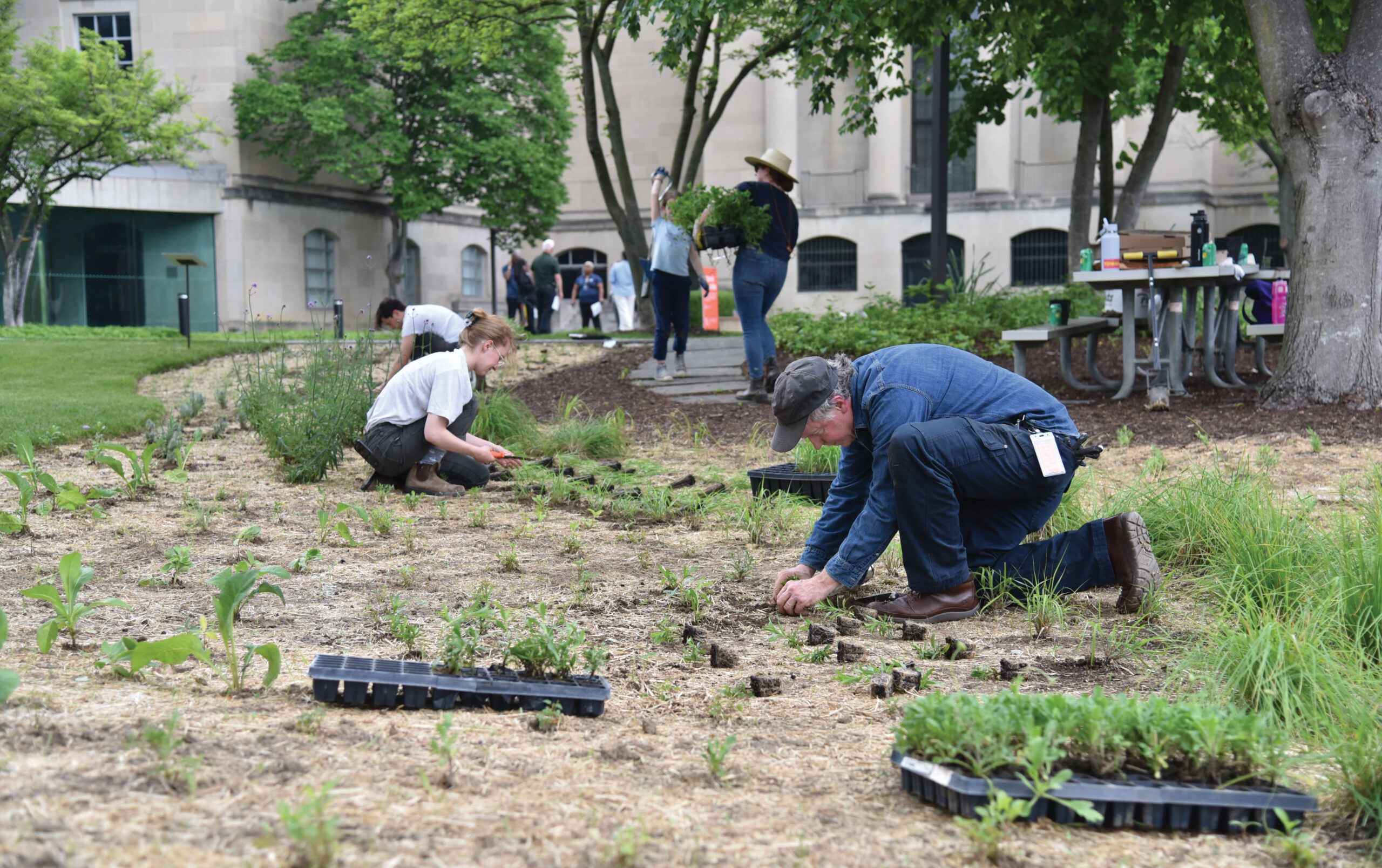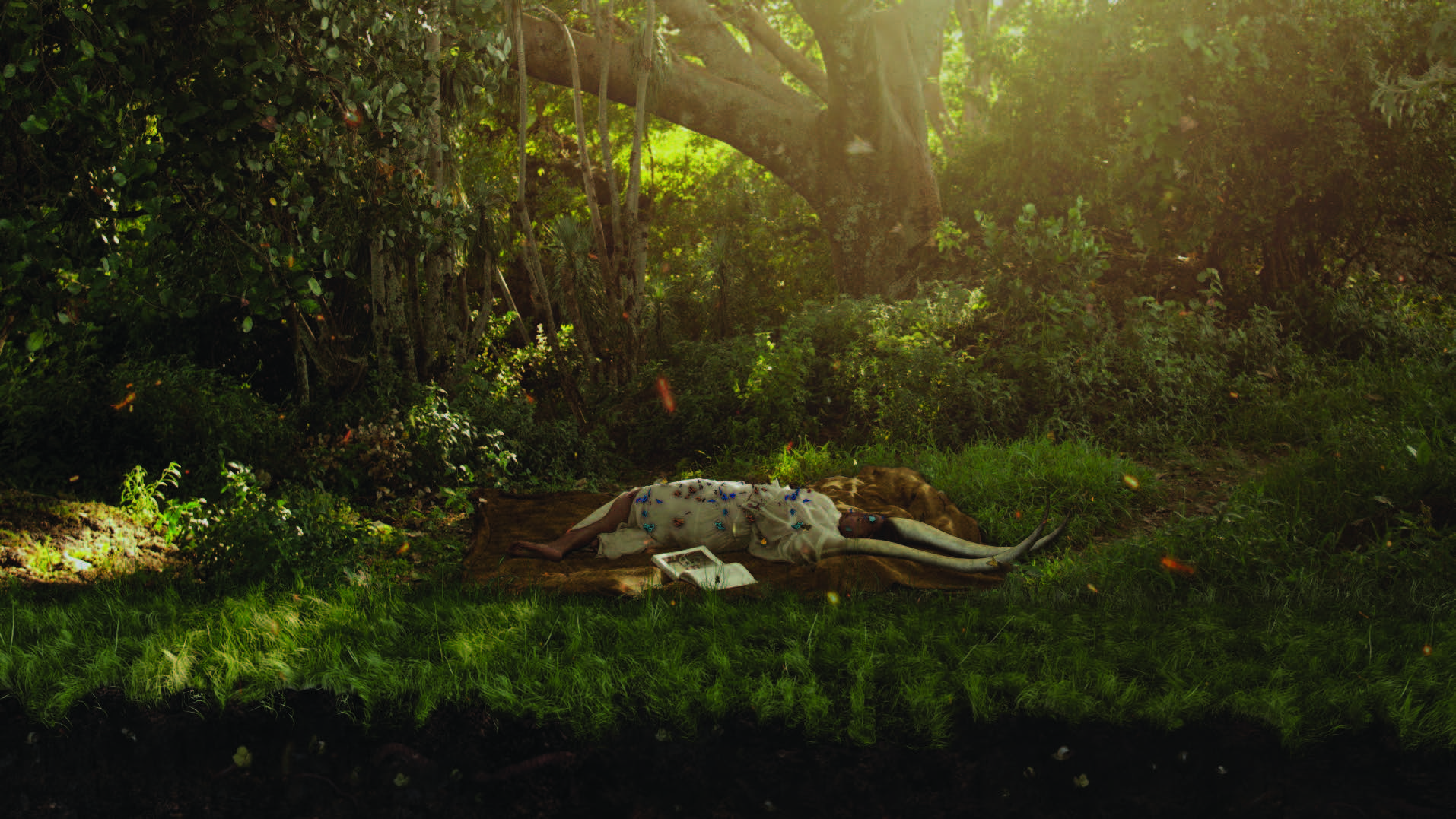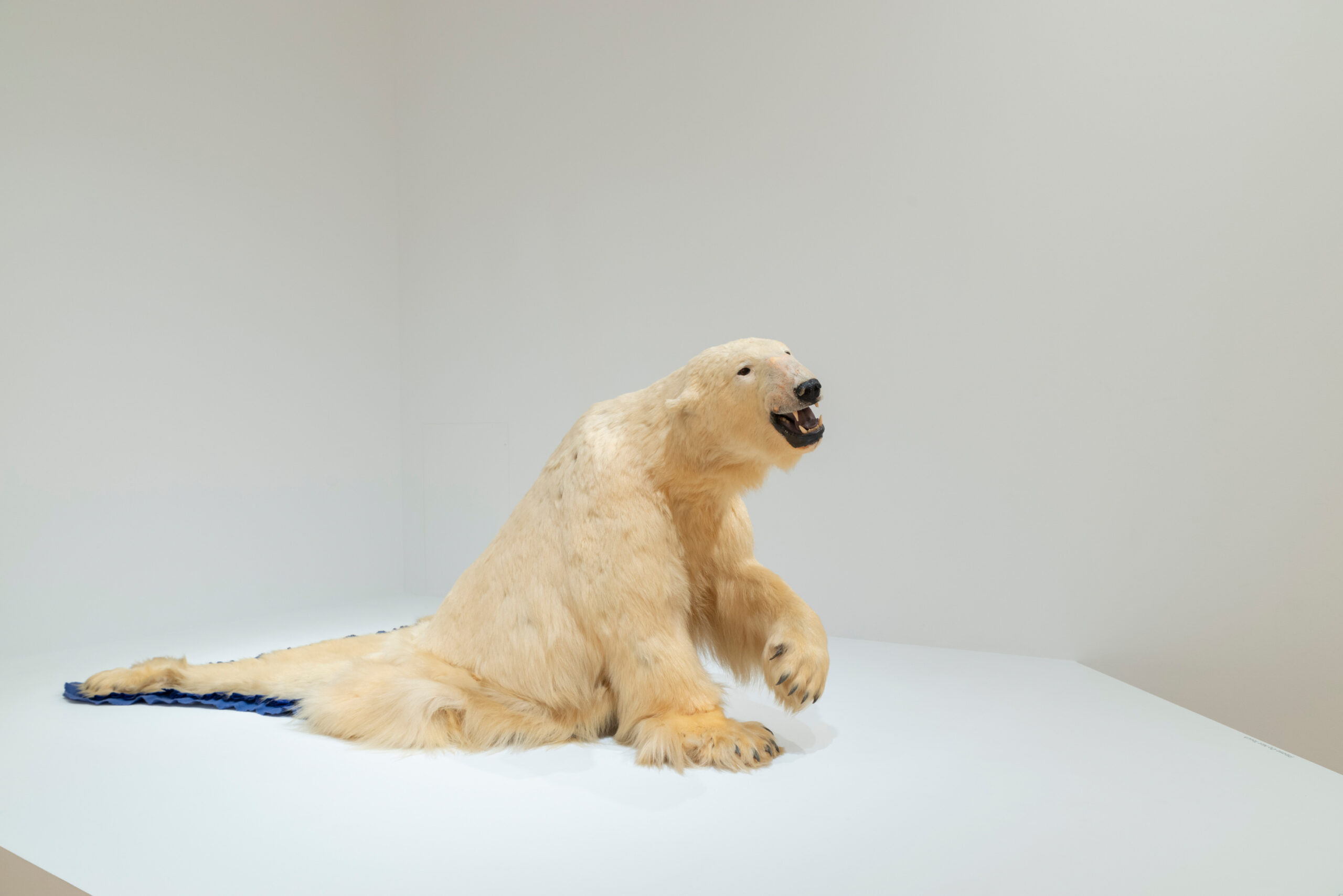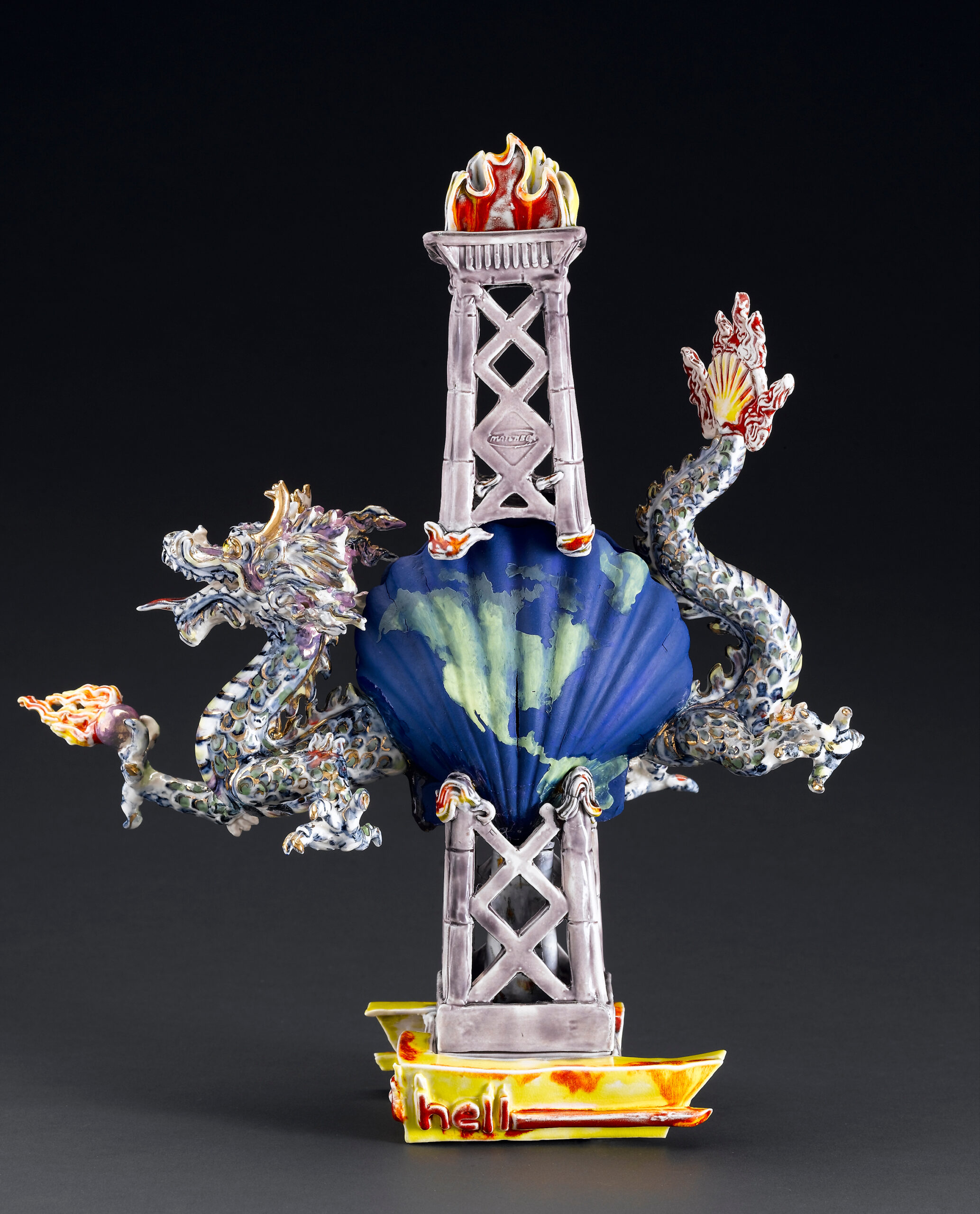
Teetering on a ceramic oil rig, Pecten Shell Teapot refashions centuries-old art motifs and porcelain recipes to tell a story about today’s environmental crisis. A dragon’s head and tail form the spout and handle of the teapot, respectively. Insatiable, the creature strides forward in a never-ending chase for a flaming pearl. For ceramicist Michelle Erickson, the scene represents “our perilous addiction to fossil fuels.”1 “Our” refers to the world that Erickson references in the shape of a pecten shell featuring outsized portrayals of North America and Asia, the world’s largest consumers of fossil fuel.
This working teapot is part of an exhibition of work by Michelle Erickson titled Recasting Colonialism: Michelle Erickson Ceramics on view at the Baltimore Museum of Art from May 7 to October 1, 2023, which includes highlights from the artist’s decades-long environmental activism through the ceramic medium. The sculptural design represents a contemporary feud between China and America fueled by a global demand for fossil fuels. The oil and gas market demand are spearheaded by multi-national corporations like Shell, whose name Erickson separates around the base of the teapot to spell “hell” on one side. Noting the relevance of the past to the present, Erickson locates the source of this environmental abuse in the colonial period, when ceramics became the center of global trade wars.
Under the references to a modern world imperiled by fossil fuel consumption, Erickson baked into the piece the history of porcelain and a desire for commodities that shaped the global trade of European decorative arts. For the body of the porcelain dragon and rig as well as the jasperware teapot center, Erickson studied recipes for a clay mixture found in an 18th-century archive like those at the Wedgwood factory.2
Conceptually, the form of this teapot also draws heavily on artistic motifs that flourished during the same period. When European ceramicists finally cracked the code on their own recipe for porcelain at the Meissen Factory outside Dresden in the early 1700s, many designs and motifs were borrowed from centuries of imported Asian ceramics. Erickson’s dragon nods to the appropriation of Asian symbols in European ceramics, also on display in the shape of the Chinese guardian lion (or foo/fu dog) featured on the cover of this Staffordshire teapot from the Baltimore Museum of Art collection (fig. 2).3 A pecten shell also forms the body of this teapot.
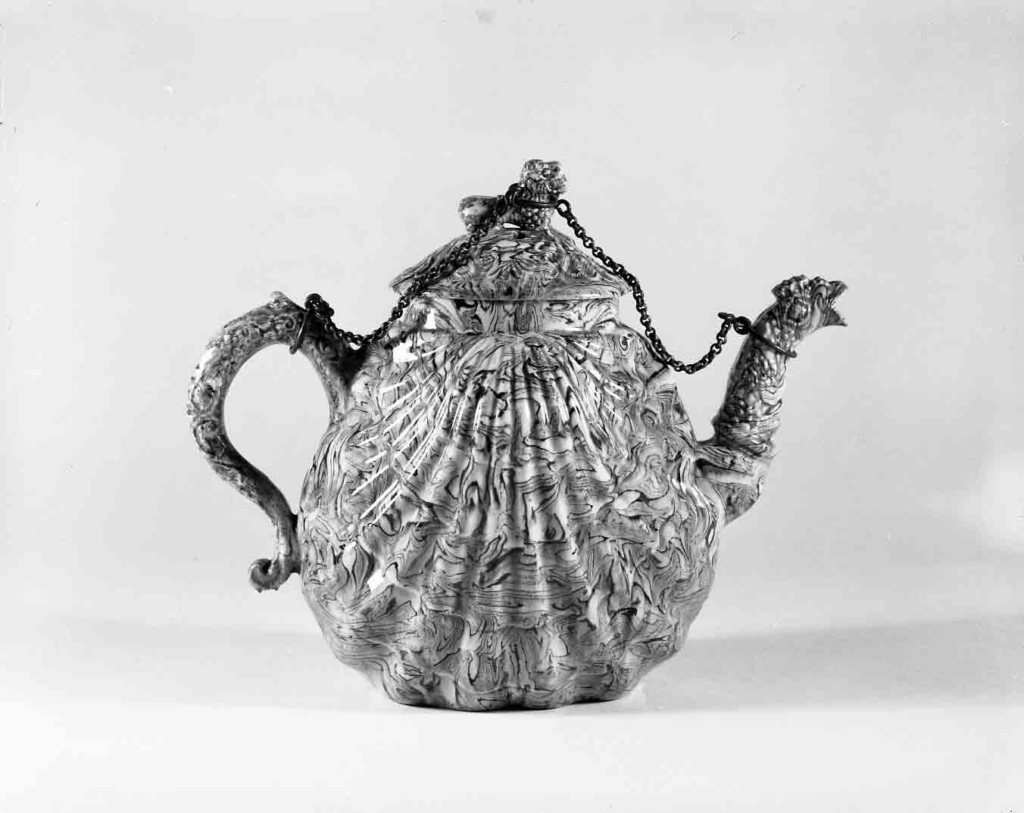
The pecten shell, also known as a scallop shell, frequently appears in European decorative arts drawing on Greco-Roman art history. The Greek goddess Aphrodite is represented as emerging from a pecten shell, which references her marine origins and simultaneously symbolizes fertility.4 This scene was perhaps mostly famously depicted by Renaissance painter Sandro Botticelli in ca. 1485, in his piece “The Birth of Venus.”5 In the Christian tradition, this type of shell was also donned as a badge by those who made a pilgrimage on the Camino de Santiago trail in Northern Spain to honor the apostle St. James the Greater. According to scripture, after his death, the apostle’s remains were brought from Jerusalem to the Galatian Coast, known for its pecten shell-covered shores.6
Reworking materials and forms with centuries of global use and meaning, Erickson addresses centuries of growing exploitation.
Shells and porcelain have long shared an intertwined history in European decorative arts. In the 1298 account of The Travels of Marco Polo, the word for shell, porcellene, was used to describe Asian porcelain, a ceramic material so fine that it resembled shells.7 Porcelain was invented in China between 200 BCE and 200 CE, but European manufacturers did not develop their own recipe for the material until the 18th century.8 In the meantime, both Asian shells and porcelain were imported alongside one another to Europe by colonial trading companies. Both objects were displayed in European made metal mounts and were often featured in kunstkammern, or curiosity cabinets. Considered to be a precursor to the modern museum, these cabinets featured foreign objects collected from around the world to demonstrate the reach and power of European colonial empires.9 Europeans could also encounter shells in grottos, elaborately decorated features of outdoor gardens, adorned with hundreds of shells, which illustrated both a bountiful natural world and, equally, man’s control over that natural world.10
Shells are both testament to and symbolic of an increasingly global, mobile Europe that sought and made claim to dominion over distant lands and seas and the resources they found there. Erickson’s piece captures this history and ties it to a present global moment of resource extraction, represented by the oil rig. This present moment was arguably made possible by habits of mind that conceptualized the natural world as fertile and abundant—to be extracted from without need for limits—through the lens of the shell and the porcelain it became a part of. It’s perhaps no surprise at all then that Erickson’s shell oil rig references the oil giant Shell Global, a company that was supposedly named after seashells that company founder Marcus Samuel imported from Asia, and today proudly boasts the pecten shell as its logo.12
Erickson’s piece depicts the process by which Shell Global, among other companies, use infrastructures like the oil rig to literally split open the earth’s crust to extract fossil fuels—alluding to the immense, global ruptures created by the industry. Found everywhere from the offshore reserves of Equatorial Guinea to the Prudhoe Bay Oil Field in Alaska, oil extracted by such rigs is then shipped to refineries where it is converted into petroleum. In its wake, the industry leaves behind polluted oceans from accidental spills, catastrophic train derailments that pollute the air and drinking water, and, even in the absence of accidents, toxic air pollution from the refinement process. This pollution and the climate change caused by energy intensive lifestyles fed by oil extraction are borne disproportionately by communities already disenfranchised by global capitalism. Erickson’s piece is then a critique of the “hell” the industry creates.
Reworking materials and forms with centuries of global use and meaning, Erickson addresses centuries of growing exploitation. She also calls for energy transition towards alternatives that might redress both past and present injustices of colonialism and global capitalism and reform our cracked planet.
Recasting Colonialism: Michelle Erickson Ceramics is organized by Brittany Luberda, Anne Stone Associate Curator of Decorative Arts. Chloe Brettmann conducted research for the exhibition as the 2022 Metcalf Intern for Decorative Arts at the Baltimore Museum of Art.
1 Michelle Erickson, “Artist’s Statement”, see www.michelleericksonceramics.com/?action=about, accessed September 7, 2023
2The Wedgewood ceramics factory was founded by potter and businessman Josiah Wedgwood in the middle of the 18th century in Stoke-on-Trent, in central England. The business was passed down through the family for centuries and continues to produce porcelain and other ceramics today. The brand is known for its signature unglazed jasperware. For more on the Wedgewood Factory and its founder see Anthony Burton, Josiah Wedgwood: A New Biography (Yorkshire – Philadelphia: Pen & Sword History, an imprint of Pen & Sword Books Ltd, 2019).
3For more on the appropriation and movement of Chinese ceramics, see Stacy Pierson, “The Movement of Chinese Ceramics: Appropriation in Global History.” Journal of World History 23, no. 1 (March 2012): 9–39. http://www.jstor.org/stable/41508050.
4It is sometimes mistakenly thought that Aphrodite (also known by her Roman name Venus) was born from a pecten shell. Classical references, such as Hesiod’s poetry, describe her as born from the sea foam, however popular Renaissance and Early Modern artwork often use the pecten shell to symbolize her marine origins. For more on this see James Laver, “The Cradle of Venus” in The scallop; studies of a shell and its influences on humankind, ed. Ian Cox, (London: “Shell” Transport and Trading Co, 1957).
5Botticelli’s “Birth of Venus” is on display in the Uffizi Gallery in Florence, Italy. See the painting on Google Arts & Culture here: https://artb.ma/48jGd5X.
6Christopher Holder, “The Badge of St. James” in The scallop; studies of a shell and its influences on humankind, ed. Ian Cox, (London: “Shell” Transport and Trading Co, 1957). For more on the pecten shell as a modern symbol of the pilgrimage see Samuel Sánchez y Sánchez and Annie Hesp, The Camino De Santiago in the 21st Century: Interdisciplinary Perspectives and Global Views (New York: Routledge, 2015).
7Anna Grasskamp, “Shells, Bodies, and the Collector’s Cabinet” in Conchophilia: Shells, Art, and Curiosity in Early Modern Europe, ed. Marisa Ann Bass, Anne Goldgar, Hanneke Grootenboer, and Claudia Swan (Princeton: Princeton University Press, 2021). See pages 59-62.
8Hard paste European porcelain (like that manufactured in Asia) was first manufactured at the Meissen factory outside Dresden at the turn of the 18th century. For more on this see Ingelore Menzhausen and Jürgen Karpinski, Early Meissen Porcelain in Dresden. (New York, N.Y.: Thames and Hudson, 1990).
9Curiosity cabinets were recently the subject of a temporary exhibit at the Musée de Luxembourg. See Claudia Brink, Mirror of the World: Masterpieces from the Dresden Cabinet of Curiosities. September 2022 – January 2023. https://artb.ma/46dZ7Kl.
10Róisín Watson, “Shells and Grottos in Early Modern Germany” in Conchophilia: Shells, Art, and Curiosity in Early Modern Europe, ed. Marisa Ann Bass, Anne Goldgar, Hanneke Grootenboer, and Claudia Swan (Princeton: Princeton University Press, 2021).
11“About Us,” Our Heritage / Brand History, Shell Global, accessed August 28th, 2023. https://artb.ma/44XXtek.


